Faces of Thredbo
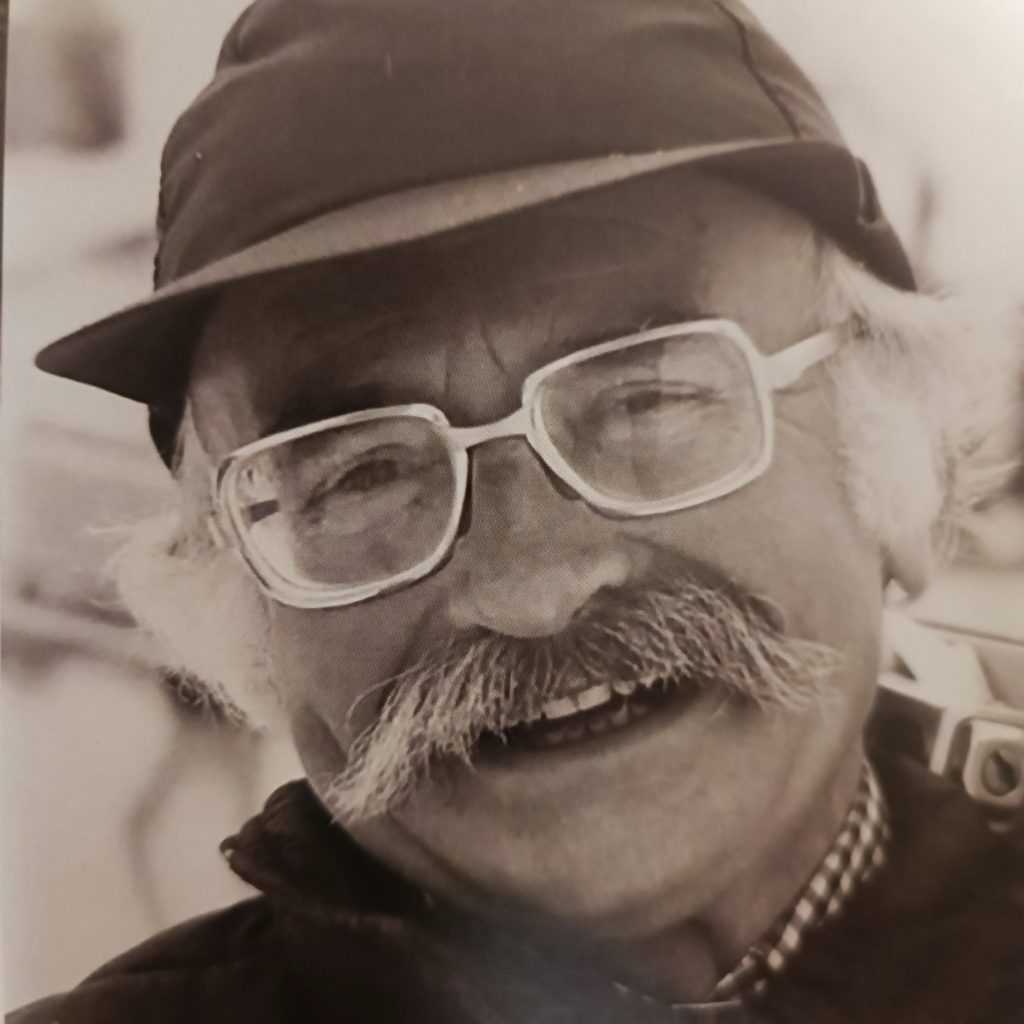
Frank Prihoda
(1921 – 2022)
“Adventures. Don’t be afraid to take risky situations, go through them and try and do it for yourself. If you sit on your back and don’t do these things you will short change yourself and miss out on life experiences.” – Frank Prihoda
Leaving Czechoslovakia
Having fled the communist regime of his native Czechoslovakia in 1949 by crossing a frozen lake into Austria, Frank Prihoda knew a thing or two about risky situations. Yet, he certainly wasn’t one to back down from a challenge and kept company with those who didn’t either.
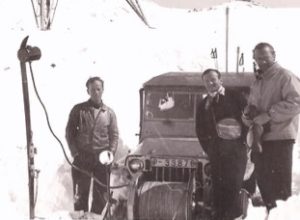
Tony Sponar with Frank Prihoda & his World War 2 Jeep & Karel Nekvapil (Thredbo Historical Society)
Along with his brother-in-law, Karel Nekvapil, and good friend Tony Sponar, upon escaping into Austria they installed and operated a portable ski tow at Saint Christoph am Arlberg, the first ever ski lift installed at this now legendary location. Of the three, Frank was the first to make his way to Australia to start a new life. Being able to pay for his passage onboard the Greek passenger ship Cyrenia, Frank arrived in Australia in 1950, not as a government-assisted migrant, but as a man free to choose his location and job opportunities. As an expert in manufacturing artificial flowers, he landed a job in Melbourne.
Representing Australia
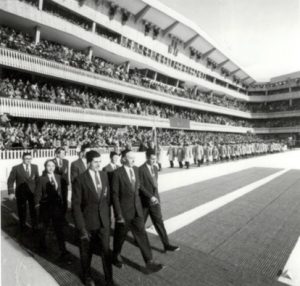
1956 Winter Olympic Games Cortina d’Ampezzo Italy
His first experience with our “wet” Australian snow was the next year, at Mount Buller. Skiing as a sport was in its infancy at this time, so as a member of the University Ski Club, Frank was soon teaching younger skiers proper technique, and winning a number of races. One of Frank’s crowning achievements was competing in the 1956 Winter Olympics in Cortina d’Ampezzo, Italy – an Olympics apparently cursed by lack of snow – but altogether an accomplishment which he had never dreamed possible. It also hastened his naturalization as a true-blue Aussie. Australia sent a small downhill alpine skiing team of four men and one woman, that were coached by Austrian Leonhard Erharter (later to become the first Ski School Director at Thredbo).
Calling Thredbo Home

Frank and his sister Sasha Nekvapil (Thredbo Alpine Museum)
Thredbo, where Frank was to live for 43 out of his 67 years in Australia, finally became his home in 1974. His sister Sasha ran Thredbo’s second lodge and imported ski fashions from Europe, whilst Frank ran his own souvenir shop in the village for 27 years. During the Sydney 2000 Olympic Games, it was Frank who carried the torch through Thredbo.
Having passed away in 2022 as Australia’s then oldest living Olympian, aged 101, the torch of his legacy continues to burn. He has left an indelible mark on Thredbo – up there on the face of the mountain, amongst Sponars T-Bar, Sashas Schuss and Karels T-Bar.
One Thredbo.
One Community.
One Frank.
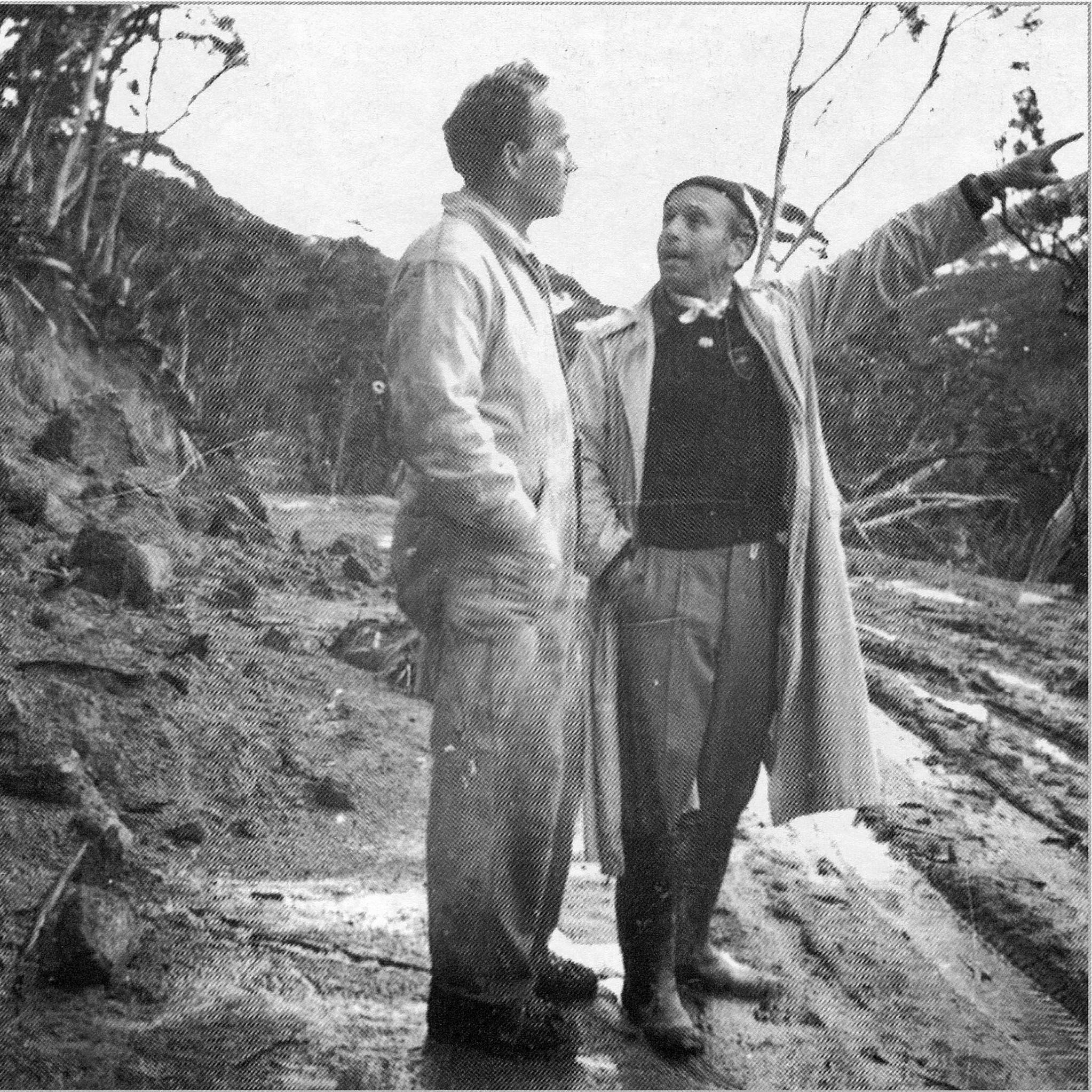
Charles Anton and Tony Sponar
(1916 – 1966 & 1920 – 2002)
There may be some contention as to who exactly founded Thredbo, but there can be little doubt that it wouldn’t have existed without the efforts of these two human dynamos: Charles Anton and Tony Sponar.
Antonin (Tony) Sponar
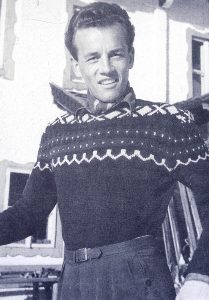
Tony Sponar as a young man in Europe (Thredbo Alpine Museum)
“When I decided – it was during the War, or maybe already before the War – that my future is in snow…I believed that whenever there is snow there should be some kind of facilities to use the snow. So I was convinced that the same thing could happen in Australia; that it has to happen.”
A National Champion

Tony Sponar lauded in the Czech press for his 9th place in the combined (Downhill & Slalom) in the 1948 St Moritz Winter Olympic Games (Thredbo Historical Society)
After World War II, having made the decision that his future would be in snow, Tony Sponar (born Antonin Sponar), wasted no time in getting back into ski racing. In 1946, he won slalom in the Hahnenkamm race – the 2nd oldest, and one of the most prestigious, alpine ski races in the world that takes place annually in the Kitzbühel Alps of Austria. He also went on to place 9th (Downhill & Slalom) in the 1948 Winter Olympics in St. Moritz. Thus, by 1949, Sponar was the unbeaten Czechoslovakian skiing champion. However, with the rise of communism, Tony knew he could not remain in his native land. Good friends with Frank Prihoda, it was Sponar who rigged a portable ski lift on top of Frank’s Jeep under the guise of needing the equipment to train the Czechoslovakian National Ski Team. Then he drove across the border into Austria, never to return.
The Formation of a Dream
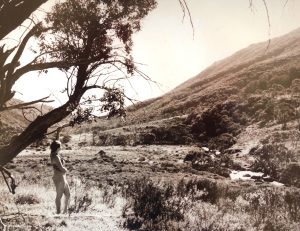
1-10 Elisabeth Sponar gazing at the completely undeveloped site of the future Thredbo 1950’s (Thredbo Alpine Museum)
After two years working at a ski resort in Austria, Tony was able to seek refuge in Australia, where he began a contract as a ski instructor – one of only two in NSW. Prior to this engagement, Sponar hadn’t even known there was any snow in Australia. With a firm conviction that where there is snow, there should be infrastructure to access and enjoy it, Sponar had a dream of establishing a European-style ski resort in the Snowy Mountains, particularly in the “hidden valley” at the bottom of the Ramshead Range. By 1954, working as a hydrographer with the Snowy Mountain Scheme, he had the means and opportunity to investigate further, and along with Charles Sponar, formed a syndicate of five men, which would make his dream a reality.
Moving On
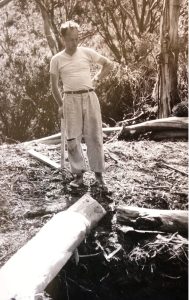
3-2 Building a bridge over the Thredbo River, 1956 (Geoffrey Hughes Collection)
Sponar was instrumental in establishing Thredbo resort at its current site. He knew what it took to build a successful international resort. He cleared the path for the first chairlift, and with his wife he managed the burgeoning village…But his influence wasn’t to last. By 1958, he’d had a falling out with the man with the money. He moved on from Thredbo to own and restore the burned out shell of the old Kosciusko Hotel – known today as Sponars Chalet.

With Piggy on Jinderboine Hill in 1983
Those who knew Sponar in the latter years may remember his pet pig, Piggy, which would ride shotgun around town in his Ferrari Dino. There may or may not have been a blow up doll in the back seat. Creative and flamboyant, yet hard-working…We owe Thredbo to Sponar’s initiative.
Yet, Thredbo, and the Australian snow sports industry in general, owes much to Charles Anton’s networking and publicity magic.
Charles Anton
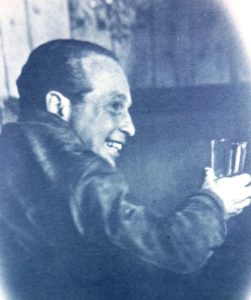
Charles Anton, c 1960 (Thredbo Alpine Museum)
‘A Short, Noisy Man’
Sponar recalls being roped into volunteering for one of Charles’ projects upon their first meeting:
“On our first weekend at the Chalet, a short, noisy man appeared. In no time, he had introduced himself as Charles Anton and just as fast he had told me that I should be the one to help him with his current project.” – Tony Sponar
Charles, a 5ft 4inch squeeze-box playing, thrice-married insurance broker, was a showman at heart. Among other things, he is remembered for throwing lavish parties – some involving Glühwein and lederhosen – to celebrate the openings of new ski chalets. He is described as having an infectious enthusiasm, and an unstoppable determination against opposition.
Forward-Thinking
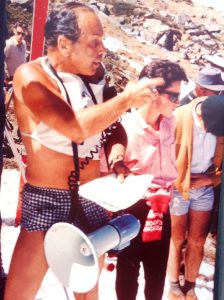
Charles Anton officiating at the summer races (Thredbo Alpine Museum)
Born in Austria in 1916, of Jewish heritage, he was forced to flee the Nazis, which brought him to Sydney in 1938. Austria’s loss was our gain, as Charles brought his fondness for ski touring, Austrian-style, to the Snowy Mountains. The founder and president of the Ski Tourers Association, his main interest in establishing Thredbo was in developing a chain of simple ski huts all across the mountains to facilitate multi-day ski trips such as he had embarked on in Austria. In the interests of promoting Thredbo, he was instrumental in organizing ski racing events, and bringing over Austrian ski instructors to develop a world-class ski school. He also established Kareela Hutte. As skiing started to move from an elitist sport to a mass industry, he realized a need for more luxurious, resort-style accommodation to cater for a wider market. As the Director of Thredbo, he knew that to allow for further expansion, it had to be sold. In 1961, Lend Lease took over.
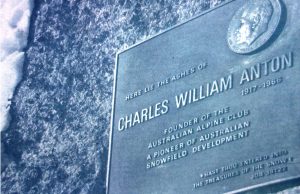
Anton plaque at Eagles Nest (Jerry Krejzar Collection)
For his next venture, Charles was planning to establish another Thredbo-like resort in Victoria. His sudden death from meningitis put an end to this dream, and the Australian ski community lost some of its “colour” (Canberra Times). His memory is still embedded in the land of Thredbo – his ashes interred in granite, at the top of Kosciuszko Chairlift.
One Thredbo.
One Community.
One Anton and One Sponar.

Elyne Mitchell
(1913 – 2002)
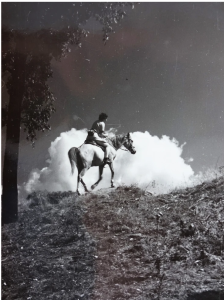
Elyne on horseback, from the Mitchell Family Collection (Donated by Honor Auchinleck)
“We knew these mountains in the days when only the cattlemen went up there, riding round the cattle all summer through, and when, in the winter, there were only the few skiers and the snow, the wild blizzards, the black cockatoos and always the lovely untracked snow.” – Elyne Mitchell
An Adventurer

Elyne with her foot in a cast, from the Mitchell Family Collection (Donated by Honor Auchinleck)
Before there were luxurious lodges and ski resorts with chairlifts, Elyne had skied with her husband, Tom, across the Main Range and into inaccessible “hidden” valleys. Not having grown up skiing, Elyne had to learn quickly once she had married Tom, who was already a champion skier. Elyne soon became one herself, winning competitions abroad, and braving sheer undeveloped cliff faces at home.
A Writer
Sentinel Peak was named by Elyne in 1941. She was also the first to pen her experience of skiing Dead Horse Gap in her 1942 book, Australia’s Alps, and noted with foresight that the Crackenback area would be suitable for an alpine village settlement. Her Silver Brumby book series, written for her daughter Indi, romanticizes a brumby kingdom that reigned in the area of Cascade Hut during the time when only cattlemen came and went with the summer season. As the series goes on, the brumbies encounter the progress of western civilization, starting with the formation of wide roads. Next, they see the “twinkling lights” of Thredbo.
The End of ‘the End of the World’
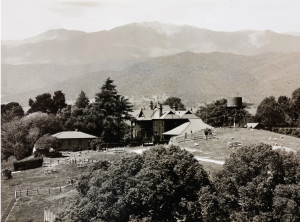
Towong Hill, from the Mitchell Family Collection (Donated by Honor Auchinleck)
This was a “progress” happening in real-time for the Mitchells, who viewed the advance of industry in the Snowy Mountains, and its accompanying changes on the landscape, with mixed feelings. Tom, as a parliamentarian, was a keen advocate for the Upper Murray region in which they lived, whilst Elyne, having looked after their cattle station during World War II, had come to be deeply connected to the land. The cattle station which was home to The Mitchells and their four children was on the western side of the Snowies, at Towong Hill, Victoria – a place at the end of the road that had felt “at the end of the world”. The construction of Thredbo and the Alpine Way was to change all that.
A New Community
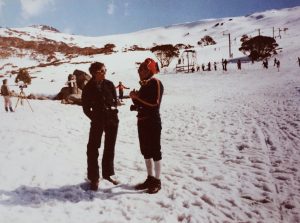
Elyne at Thredbo, from the Mitchell Family Collection (Donated by Honor Auchinleck)
They were invited to see the site which was to become Thredbo Resort by Charles Sponar, who visited them at their home and told them of his grand vision. At the time, Thredbo was just a “cut in the bush” but it was to become the setting of new adventures for Elyne and her children. In the 60s, Elyne’s daughter Honor recalls that the family would stay at the Ski Club and ski for up to three days each week, in addition to school holidays. It was here that Elyne found release from the pressures of station and political life and became part of a community where she felt she could be herself without any expectations. She became good friends with Frank Prihoda, and Karel and Sasha Nekvapil, who expanded her knowledge of European life, culture, and politics. People also noted that she particularly loved to ski with Leonhard Erharter, the director of the ski school, and was passionate about skiing with perfect parallel technique. To Elyne, to ski was to dance. The dance continued up until she laid down her skis aged 77.
A Life Lived in Service
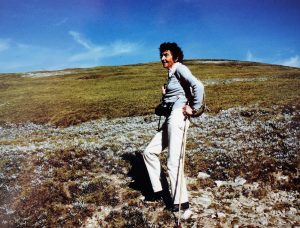
Mitchell Family Collection (Donated by Honor Auchinleck)
Elyne died aged 88, having known what it was to live in isolation through World War 2, battle fires and floods, work hard mustering cattle, raise four children, then lose one. The Medal of the Order of Australia, as well as an honorary doctorate of letters from Charles Sturt University, had been awarded to her for services to literature. She had published 33 books, and given people from all over the world a glimpse into life in the Australian Snowies.
At Thredbo, we’ll always remember Elyne as a tall and fit figure, with a twinkle in her eye, cutting perfect lines down Crackenback as if she were dancing on “winged skis”.
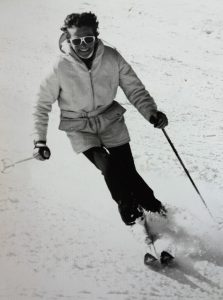
Mitchell Family Collection (Donated by Honor Auchinleck)
One Thredbo.
One Community.
One Elyne Mitchell.
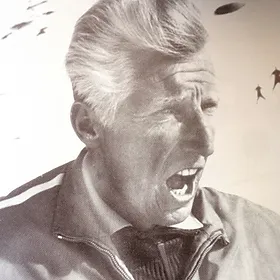
Leonhard Erharter
(1928 – 2007)
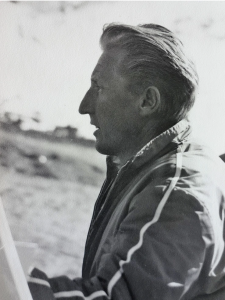
Mitchell Family Collection (Donated by Honor Auchinleck)
“I was going up the Merritts Chair one morning and could see a skier coming down through the deep crud like it was a foot of dry powder. I knew how deplorable the snow was having hardened overnight on a slope that few ventured on. It was Lenny…” – Frank Hussey
An Injury
The first Ski School Director of Thredbo, Leonhard, or Lenny as he was affectionately known, was born in Austria and showed promise as a ski racer from a young age. Unfortunately, severe injuries from crashing into a tree to avoid a wayward spectator put a stop to racing ambitions. However, the incident didn’t stop him from pursuing his passion.
Technically Perfect
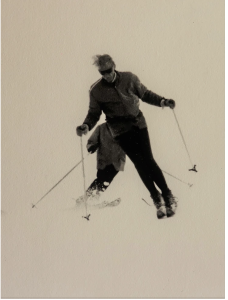
Mitchell Family Collection (Donated by Honor Auchinleck)
As well as earning an engineering degree from the University of Bern in Switzerland, Erharter studied at the elite Austrian Federal Ski School. Fortuitously, it was Leonhard who coached the Australian ski team at Zurs for the 1956 Cortina Winter Olympics. A technically perfect skier, he was recommended to the first Thredbo founding syndicate to head up their ski school. With Leonhard at the helm, joined by other exceptional European talent such as Helmut Pfister, Thredbo quickly developed a ski school of renown.
Maintaining the Mountain
Among other things, Erharter was also the Mountain Supervisor. He was a hard worker, and according to Frank Hussey, “hard to work for”. A lot of manual labor was involved to keep the slopes groomed, and runs clear. There was also the development of new runs, such as Bluff and Cannonball, that are partly owed to Lenny’s enthusiasm of taking on challenging tracks.
Changing Seasons
After the Australian winter, Leonhard would head to Idaho where he instructed at Sun Valley Resort. There he married Miss Sarah Jane Coleman, the American daughter of the Duchess of Manchester and an investment banker.
In 1977, his time as the Director of the Thredbo Ski School came to an end, but he was a character still fondly remembered by many…From inspiring future ski school directors to learn German and study in Austria, to coaching others to Olympic success, Leonhard had a subtle impact, that will reverberate through generations.
One Thredbo.
One Community.
One Leonhard Erharter.



